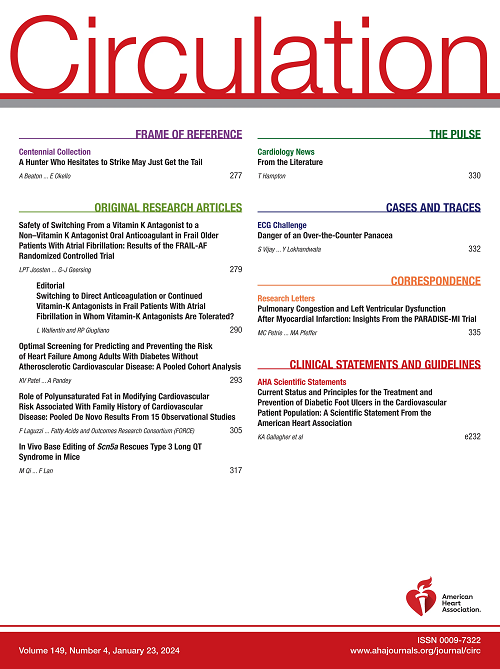Abstract 12440: Depression and Anxiety Accelerate the Rate of Gain of Cardiovascular Risk Factors: Mechanism Leading to Increased Risk of Cardiac Events
IF 38.6
1区 医学
Q1 CARDIAC & CARDIOVASCULAR SYSTEMS
引用次数: 0
Abstract
Introduction: Depression and anxiety are associated with a greater incidence of major adverse cardiovascular events (MACEs). Hypothesis: We hypothesized that: 1) depression and anxiety accelerate the development of cardiovascular risk factors (CVDRFs), which in turn significantly heightens MACE risk, and 2) a genetic marker of stress sensitivity (polygenic risk score for neuroticism; nPRS) also associates with accelerated gains of CVDRFs. Methods: Subjects enrolled in the Mass General Brigham Biobank were studied. Depression, anxiety, CVDRFs and MACE were defined using ICD codes. Subjects <18 years old, with previous MACE or who developed depression/anxiety after study start date were excluded. CVDRFs were defined as hypertension, hyperlipidemia, and diabetes mellitus. The time between study start date and development of first new CVDRF was measured over 10 years of follow-up. Additionally, nPRS was assessed for subjects who provided genetic data; age of first CVDRF diagnosis was ascertained in this subgroup. Results: Data were obtained for 71,262 subjects (age 49.0 ± 15.6 yrs, 44.7% male). 27,048 (38.0%) subjects gained a new CVDRF (mean time 4.8 ± 2.6 yrs). Depression (β=-0.591; p<0.001) and anxiety (β=-0.567; p<0.001) associated with earlier development of a new CVDRF after adjusting for age, sex, and preexisting CVDRFs ( Fig. 1A). Further, in adjusted analyses, depression and/or anxiety increased the risk of MACE (adjusted odds ratio: 1.353; p<0.001). Mediation analysis shows that 38.9% of the effect of depression and/or anxiety on MACE is explained by the accelerated gains in CVDRFs. Similarly, higher genetic sensitivity to stress (nPRS) associates with an earlier onset of first CVDRF (adjusted β=-0.317; p=0.005, Fig. 1B) . Conclusions: Depression and anxiety accelerate the acquisition of CVDRFs, which in turn significantly explains the heightened risk of MACE. Genetic risk associated with stress sensitivity also accelerates the development of CVDRFs.摘要 12440:抑郁和焦虑会加快心血管风险因素的增加速度:导致心脏事件风险增加的机制
简介 抑郁和焦虑与重大不良心血管事件(MACE)的发生率增加有关。 假设 我们假设1)抑郁和焦虑会加速心血管风险因素(CVDRFs)的发展,进而显著增加 MACE 风险;2)压力敏感性的遗传标记(神经质的多基因风险评分;nPRS)也与 CVDRFs 的加速发展有关。 研究方法 研究对象加入了 Mass General Brigham 生物数据库。抑郁、焦虑、CVDRFs 和 MACE 均使用 ICD 代码进行定义。年龄小于 18 岁、既往有 MACE 或在研究开始日期后出现抑郁/焦虑的受试者被排除在外。CVDRF定义为高血压、高脂血症和糖尿病。在 10 年的随访期间,测量了从研究开始日期到首次出现新的 CVDRF 之间的时间。此外,还对提供基因数据的受试者的 nPRS 进行了评估;并确定了该亚组首次诊断出 CVDRF 的年龄。 结果: 共获得 71262 名受试者(年龄 49.0 ± 15.6 岁,44.7% 为男性)的数据。27,048 名受试者(38.0%)获得了新的 CVDRF(平均时间为 4.8 ± 2.6 年)。在调整年龄、性别和既往 CVDRF 后,抑郁(β=-0.591; p<0.001)和焦虑(β=-0.567; p<0.001)与较早出现新的 CVDRF 有关(图 1A)。 此外,在调整后的分析中,抑郁和/或焦虑会增加 MACE 的风险(调整后的几率比:1.353;P<0.001)。中介分析表明,抑郁和/或焦虑对 MACE 的影响有 38.9% 是由 CVDRFs 的加速增益所解释的。同样,遗传对压力的敏感性越高(nPRS),首次 CVDRF 的发生时间就越早(调整后的β=-0.317;p=0.005,图 1B)。 结论 抑郁和焦虑会加速心血管危险因素的获得,这反过来又极大地解释了MACE风险升高的原因。与压力敏感性相关的遗传风险也会加速心血管危险因素的发展。
本文章由计算机程序翻译,如有差异,请以英文原文为准。
求助全文
约1分钟内获得全文
求助全文
来源期刊

Circulation
医学-外周血管病
CiteScore
45.70
自引率
2.10%
发文量
1473
审稿时长
2 months
期刊介绍:
Circulation is a platform that publishes a diverse range of content related to cardiovascular health and disease. This includes original research manuscripts, review articles, and other contributions spanning observational studies, clinical trials, epidemiology, health services, outcomes studies, and advancements in basic and translational research. The journal serves as a vital resource for professionals and researchers in the field of cardiovascular health, providing a comprehensive platform for disseminating knowledge and fostering advancements in the understanding and management of cardiovascular issues.
 求助内容:
求助内容: 应助结果提醒方式:
应助结果提醒方式:


